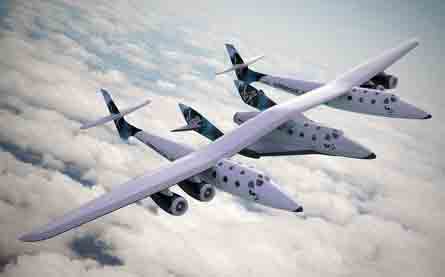Will the second decade of the 21st century finally see the dawn of personal spaceflight as a practical, fare-paying, scheduled reality? Virgin Galactic certainly thinks so. Last week, in a major presentation at the American Museum of Natural History in New York, it unveiled its designs for the carrier aircraft and spacecraft combination that will lift passengers to the edge of space before rocketing them to a short sub-orbital adventure.
The carrier aircraft, White Knight II, and the spacecraft, SpaceShipTwo, are both radical departures from the SpaceShipOne and White Knight designs used in 2004 to win the $10 million Ansari X Prize for making the first private space flight. Moving on dramatically, Burt Rutan's Scaled Composites has produced a configuration for SpaceShipTwo (SS2) that recalls the US Air Force-NASA X-20 Dyna-Soar project, while White Knight II looks set to become only the second twin-fuselage aircraft ever to go into production.
With an entry into service date of no earlier than 2010, the WK2/SS2 launch system will fly commercially from the yet-to-be-built New Mexico based-Spaceport America. Now four-years after conceptual design work began in 2004, the WK2/SS2 test flights are planned to take place next year at California's Mojave air and space port, where Scaled is based.

From 2010, with six passengers paying $200,000 each, every flight will generate $1.2 million and Virgin Galactic is aiming to achieve two flights a day, with a five-day working week potentially generating up to $12 million. The SS2 simulator is already operational and is being used for pilot training.
The space tourism company already has more than 200 paid-up passengers whose flights - which could be completed within a month at two flights a day - would generate $40 million.
One flight a week has been the space tourism company's goal for its first year of operation, however, flying 300 customers and generating $60 million in revenue, following a $100 million planned investment over five years for the design, development, evaluation and test of SS2 and WK2. If successful, that will lead to a fleet of two WK2s and five SS2s, and Virgin Galactic has an option to buy seven more spaceships.
A further $150 million for that fleet's manufacture and ground-segment procurement and implementation is expected to bring the investment total to $250 million.
The economics of this venture were the subject of a feasibility study carried out by Scaled, for Virgin Galactic, after the 4 October 2004 flight of SS1 that saw its funder, Microsoft founder Paul Allen, win the $10 million Ansari X prize.
At its New York press conference last week, Virgin Galactic described SS2 as having the same basic technology, construction and design as its predecessor, while being twice as large and 100% composite.

However, the SS2 has borrowed heavily in its outer mould line from the NASA and US Air Force Dyna-Soar. That 1960s vehicle was to be launched on a Lockheed Martin Titan III rocket for hypersonic research, but was not built. The Dyna-Soar work that was carried out contributed to the Space Shuttle's development.
Dyna-Soar was to have been 10.6m (34.7ft) long, whereas the SS2 is 18.3m long, has a wingspan of 12.8m, a tail height of 4.5m and a passenger cabin 3.66m long and 2.28m in diameter. The SS2 entry hatch is on the port side and an escape hatch is near the starboard wing leading edge.
Released at 50,000ft (15,200m) by WK2, the rocket glider's maximum apogee is 400,000ft (130km), says Virgin Galactic president Will Whitehorn, although the published material gives a figure of 110km. Despite being so much larger than SS1, SS2 will still use a front nose skid while landing at more than 115kt (212km/h).
As well as using the same cabin design, WK2 shares many of SS2's systems but differs in its 42.7m wing and booms that give it a length of 23.7m and a tail height of 7.62m. Pilots will operate the aircraft from the right fuselage's cabin, looking at WK2 from a plan view.
There have been a number of prototype twin-fuselage aircraft, often with only one crew cabin, but the first production aircraft was the North American F-82F Twin Mustang night fighter.
The F-82F Twin had two engines, but the WK2 will have four Pratt & Whitney PW308 powerplants - as revealed by Flight International (11 September 2007). The carrier will also have a range of more than 4,200km with its SS2 payload.
The prospect of space tourism may seem an indication that 20th century dreams of a 21st century technological nirvana are on the horizon - but the technical reality is that the future will draw heavily on the past.
Source: Flight International



















